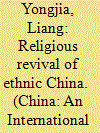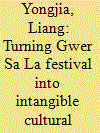| Srl | Item |
| 1 |
ID:
124655


|
|
|
|
|
| Publication |
2013.
|
| Summary/Abstract |
Over the past three decades, Chinese "ethnic areas" (minzu diqu) have experienced widespread religious revival. Religious populations are steadily increasing as the religious infrastructure expands under governmental or non-governmental sponsorship. The restoration of sacred sites appeals to the larger ethnic populations for reasons relating to community and identity (re-)creation. The officially recognised religions are reviving different regimes of transcendence in the ethnically diversified localities. Unofficial, transnational, or radical movements and denominations are engaging in activities either in the sphere of underground proselytising or non-governmental organisation (NGO) instruments. Popular religions are being legitimised through ethnic renaissance and are being embraced by astonishingly large populations. They are also being commercialised by local state agents who are given incentives to generate revenue by translating invented traditions into tourist attractions. Ancestor veneration and the Daoist rituals of consulting almanacs, geomancy, horoscopes and spirit mediums are seasoned with ethnic flavour. However, growing social, political and economic disparities are engendering greater anxiety among people who are seeking answers through the old ways such as oracle reading, mask dances, sutra chanting or karma fairs. The flow of capital, symbols, ideas and practices nationally and globally also poses unprecedented problems of religious pluralism in these increasingly mobile multi-ethnic areas.
|
|
|
|
|
|
|
|
|
|
|
|
|
|
|
|
| 2 |
ID:
124660


|
|
|
|
|
| Publication |
2013.
|
| Summary/Abstract |
The Gwer Sa La Festival of the Bai in southwest China was recently announced as a national Intangible Cultural Heritage Project and nominated for the United Nations Educational, Scientific and Cultural Organisation world ICH candidacy, largely due to the local government's promotion of Gwer Sa La's religiosity by constructing and materialising the rhetoric of survival by a primitive fertility cult and ethnic carnival. However, the key concern of the participants is Gwer Sa La's potency of prosperity, related to a series of encompassing powers vested in the patron god temples, taken care of by women congregations who renew the power of prosperity during the Festival. It is argued here that the state's efforts to turn Gwer Sa La into an ICH project is an attempt of "superscription without encompassment". The efforts are based on an imagined, primitive fertility cult that leads to sexual promiscuity and which entirely overlooks the locals' concerns.
|
|
|
|
|
|
|
|
|
|
|
|
|
|
|
|